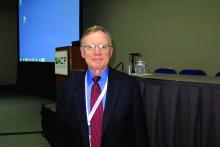SAN DIEGO – In the first year since Delaware Valley Nephrology joined an end–stage renal disease seamless care organization, patient hospitalizations have declined by 40% and rehospitalizations by 20%, according to Edward R. Jones, MD.
At the annual meeting of the American College of Physicians, Dr. Jones, a nephrologist at a Philadelphia-based practice, described his experience with the alternative payment model, which focuses on managing costs while providing better health outcomes.
The ESRD seamless care organization (ESCO) “is nothing more than a partnership between the dialysis provider and the dialysis units, who are at risk for all the Medicare beneficiaries for delivery of care and the cost of care in this patient population,” he said.More than 15 months ago, Dr. Jones and seven other nephrologists in his practice partnered with Fresenius Medical Care to form an ESCO with two other nephrology groups, amounting to 45 physicians who work out of 30 dialysis units in 14 hospitals and care for 1,000 patients.
It became one of 13 ESCOs that have been operating nationwide since October 2015. The ESCOs share savings with the Centers for Medicare & Medicaid Services if matched beneficiaries’ expenditures decrease and quality is maintained or improved, and it shares losses if beneficiaries’ expenditures increase.
To be eligible for participation in the ESCO, patients must be enrolled in Medicare Parts A and B and have Medicare as their primary payer. They are ineligible if they are enrolled in a Medicare Advantage plan. Patients must not have received a kidney transplant in the last 12 months and must receive at least 51% of annual dialysis services in the ESCO’s market area.
“The governing structure of the ESCO was critical as we put it together,” Dr. Jones said. “We insisted that a nephrologist be at the table of the governing body, as well as a consumer advocate, and no one controls more than 50% of the vote.
“The concept here is that a benchmark for spending is set,” he explained. “If your spending is less than the benchmark expenditure, there are shared savings. The opposite occurs if there are losses, so it’s a fairly straightforward program.”
To illustrate how the ESCO works, he discussed a hypothetical model in which the ESCO used $50 million of expenditures from 2012 to 2015.
“If the actual ESCO expenditures are $47 million, there are $3 million in potential shared savings,” Dr. Jones explained. “It’s potential because two things are necessary. First, you have to have hit at least 1% savings or 1% loss. This allows for any random outcomes. Of $3 million of potential shared savings, CMS keeps 25%.
“The remaining shared savings depends on where you hit on the metric performance,” he continued. “In the first year, it’s a pay for reporting [system], so all we had to do is hit three measures. So, the first year was great.”
In the second year of ESCO participation, centers have to perform in the 90th percentile on 16 metrics to get full shared savings. Drawn from Medicare claims and medical records, the list of metrics includes diabetic foot exam, medication reconciliation, and advanced care planning, and it accounts for 50% of the score. Surveys of person- and caregiver-centered experience outcomes compose 33% of the score.
“These metrics are compared to all other metrics throughout the country,” Dr. Jones said. “Wherever you fall, you generate a certain number of points, between 0 and 2. It’s tied to quality and outcomes. If you’re in the 90th percentile you get all 2 points. If you’re below the 50th percentile, you get no points.”
The goal of the ESCO is to achieve the minimal savings rate, to maximize achievement of quality metrics, and to reduce expenses below the set benchmark. In Dr. Jones’ practice area, ESRD care costs about $87,000 per patient per year – 34% are related to inpatient costs, and 30% are related to dialysis costs.
Keys to a successful ESCO include “a cooperative and engaged nephrologist” and the ability to gather analytics.
“There is no way that a practice of my size has the capability of generating the analytics to be able to risk-stratify patients,” he said. “Who is likely to be readmitted? We put all of our effort into those folks. Medication reconciliation accounts for a lot of rehospitalization. We spend a lot of time on that.”
There is also increased use of care navigators. “Our goal is for patients to call the care navigators before they call the nephrologist,” Dr. Jones said. “We have safety net clinics that are open 24/7. So, if a patient comes in on a Saturday or Sunday, we can divert the patient to those areas.”
In the first year since joining the ESCO, patient hospitalizations at Dr. Jones’ practice have declined by 40%, and rehospitalizations have dropped by 20%.
“Importantly, we know that when a patient is not in his dialysis chair within 15 minutes, the care navigator calls him,” he said. “The number of missed treatments is down dramatically.”
Dr. Jones reported owning stock in Cytosorbents. He also serves as a consultant for Fresenius Medical Care, Fresenius Medical Services, Physicians Choice Dialysis, and Reliant Renal Care. He is also an advisory board member for Cytosorbents and Fresenius.


